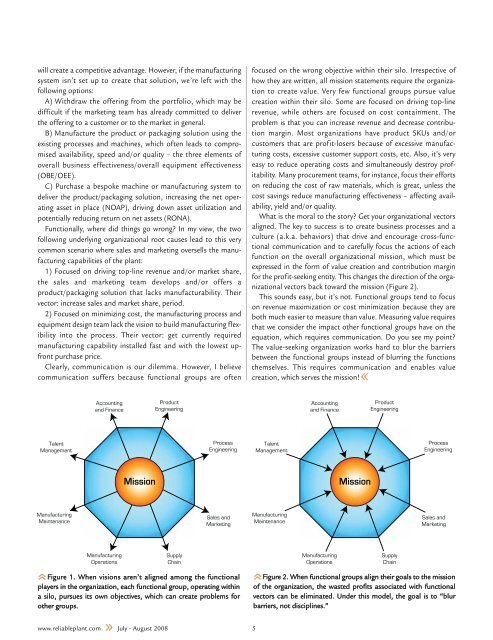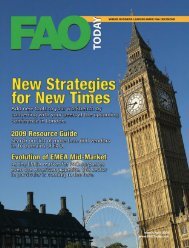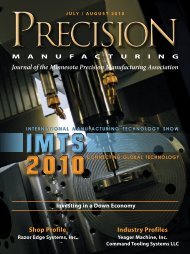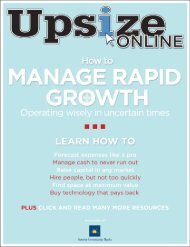Reliable Plant July August 2008
Reliable Plant July August 2008
Reliable Plant July August 2008
Create successful ePaper yourself
Turn your PDF publications into a flip-book with our unique Google optimized e-Paper software.
will create a competitive advantage. However, if the manufacturing<br />
system isn’t set up to create that solution, we’re left with the<br />
following options:<br />
A) Withdraw the offering from the portfolio, which may be<br />
difficult if the marketing team has already committed to deliver<br />
the offering to a customer or to the market in general.<br />
B) Manufacture the product or packaging solution using the<br />
existing processes and machines, which often leads to compromised<br />
availability, speed and/or quality – the three elements of<br />
overall business effectiveness/overall equipment effectiveness<br />
(OBE/OEE).<br />
C) Purchase a bespoke machine or manufacturing system to<br />
deliver the product/packaging solution, increasing the net operating<br />
asset in place (NOAP), driving down asset utilization and<br />
potentially reducing return on net assets (RONA).<br />
Functionally, where did things go wrong? In my view, the two<br />
following underlying organizational root causes lead to this very<br />
common scenario where sales and marketing oversells the manufacturing<br />
capabilities of the plant:<br />
1) Focused on driving top-line revenue and/or market share,<br />
the sales and marketing team develops and/or offers a<br />
product/packaging solution that lacks manufacturability. Their<br />
vector: increase sales and market share, period.<br />
2) Focused on minimizing cost, the manufacturing process and<br />
equipment design team lack the vision to build manufacturing flexibility<br />
into the process. Their vector: get currently required<br />
manufacturing capability installed fast and with the lowest upfront<br />
purchase price.<br />
Clearly, communication is our dilemma. However, I believe<br />
communication suffers because functional groups are often<br />
focused on the wrong objective within their silo. Irrespective of<br />
how they are written, all mission statements require the organization<br />
to create value. Very few functional groups pursue value<br />
creation within their silo. Some are focused on driving top-line<br />
revenue, while others are focused on cost containment. The<br />
problem is that you can increase revenue and decrease contribution<br />
margin. Most organizations have product SKUs and/or<br />
customers that are profit-losers because of excessive manufacturing<br />
costs, excessive customer support costs, etc. Also, it’s very<br />
easy to reduce operating costs and simultaneously destroy profitability.<br />
Many procurement teams, for instance, focus their efforts<br />
on reducing the cost of raw materials, which is great, unless the<br />
cost savings reduce manufacturing effectiveness – affecting availability,<br />
yield and/or quality.<br />
What is the moral to the story? Get your organizational vectors<br />
aligned. The key to success is to create business processes and a<br />
culture (a.k.a. behaviors) that drive and encourage cross-functional<br />
communication and to carefully focus the actions of each<br />
function on the overall organizational mission, which must be<br />
expressed in the form of value creation and contribution margin<br />
for the profit-seeking entity. This changes the direction of the organizational<br />
vectors back toward the mission (Figure 2).<br />
This sounds easy, but it’s not. Functional groups tend to focus<br />
on revenue maximization or cost minimization because they are<br />
both much easier to measure than value. Measuring value requires<br />
that we consider the impact other functional groups have on the<br />
equation, which requires communication. Do you see my point?<br />
The value-seeking organization works hard to blur the barriers<br />
between the functional groups instead of blurring the functions<br />
themselves. This requires communication and enables value<br />
creation, which serves the mission!<br />
Accounting<br />
and Finance<br />
Product<br />
Engineering<br />
Accounting<br />
and Finance<br />
Product<br />
Engineering<br />
Talent<br />
Management<br />
Process<br />
Engineering<br />
Talent<br />
Management<br />
Process<br />
Engineering<br />
Mission<br />
Mission<br />
Manufacturing<br />
Maintenance<br />
Sales and<br />
Marketing<br />
Manufacturing<br />
Maintenance<br />
Sales and<br />
Marketing<br />
Manufacturing<br />
Operations<br />
Supply<br />
Chain<br />
Manufacturing<br />
Operations<br />
Supply<br />
Chain<br />
Figure 1. When visions aren’t aligned among the functional<br />
players in the organization, each functional group, operating within<br />
a silo, pursues its own objectives, which can create problems for<br />
other groups.<br />
Figure 2. When functional groups align their goals to the mission<br />
of the organization, the wasted profits associated with functional<br />
vectors can be eliminated. Under this model, the goal is to “blur<br />
barriers, not disciplines.”<br />
www.reliableplant.com <strong>July</strong> - <strong>August</strong> <strong>2008</strong> 5
















